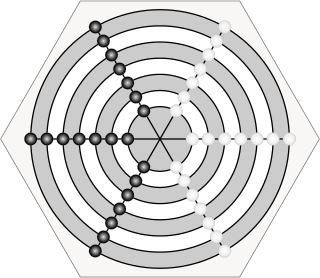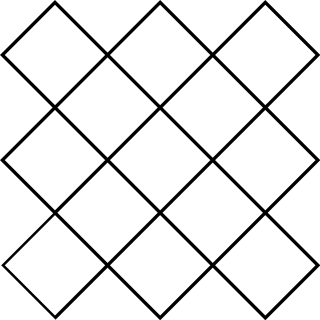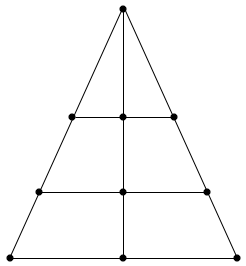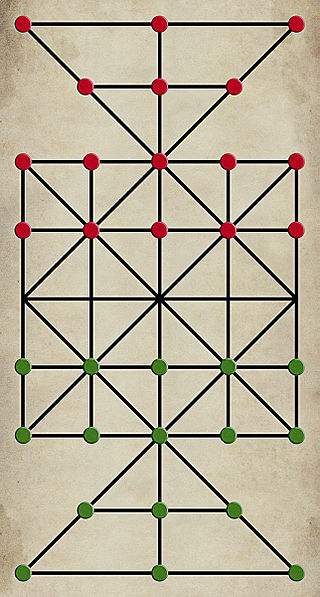Fox games are a category of asymmetric board games for two players, where one player attempts to catch the opponent's pieces, while that player moves their pieces to either trap the fox or reach a destination on the board. In one variant, fox and hounds, a single fox tries to evade the other player's hounds.
Rimau-rimau is a two-player abstract strategy board game that belongs to the hunt game family. This family includes games like bagh-chal, main tapal empat, aadu puli attam, catch the hare, sua ghin gnua, the fox games, buga-shadara, and many more. Rimau-rimau is the plural of rimau which is an abbreviation of the word harimau, meaning 'tiger' in the Malay language. Therefore, rimau-rimau means 'tigers'. The several hunters attempting to surround and immobilize the tigers are called orang-orang, which is the plural of orang, meaning 'man'. Therefore, orang-orang means 'men' and there are twenty-two or twenty-four of them, depending on which version of the game is played. The game originates from Malaysia.
Main tapal empat is a two-player abstract strategy board game from Malaysia. It is a hunt game, and specifically a tiger hunt game since it uses an Alquerque board. The tigers can move as many spaces in a straight line as a clear path allows. Most hunt games have tigers, leopards, or foxes moving only one space at a time. In effect, the tigers in this game have the movement capability of the queen in chess.

Gol-skuish is a two-player abstract strategy game from India, specifically from Central Provinces, and it was described by H.J.R. Murray in A History of Board-Games Other Than Chess (1952). The game belongs to the draughts and Alquerque family as pieces are captured by leaping over them. The board is composed of seven concentric circles divided by three diameters. Gol-skuish belongs to a specific category of games called Indian War-games which include Lau kata kati, Dash-guti, Egara-guti, and Pretwa. At the beginning of every Indian War-game all the pieces are laid out on the board at every intersection point, with the exception of the central point. This forces the first move of the game to be played on the central point, and captured by the second player's piece.

Peralikatuma is a two-player abstract strategy board game from Sri Lanka. It is a game related to draughts (checkers) and alquerque as players hop over one another's pieces when capturing them. The game was documented by Henry Parker in Ancient Ceylon: An Account of the Aborigines and of Part of the Early Civilisation (1909) with the name perali kotuwa or the war enclosure. Parker mentions that it is also played in India. It closely resembles another game from Sri Lanka called Kotu Ellima. The two games use the same board which consist of a standard alquerque board but with four triangular boards attach to its four sides. The only difference between the two games is in the number of pieces. In peralikatuma, each player has 23 pieces. In Kotu Ellima, each player has 24 pieces.
Rimau is a two-player abstract strategy board game from Malaysia. It is a hunt game, and specifically a tiger hunt game since it uses an expanded alquerque board. One tiger is being hunted by 24 men. The tiger attempts to eat the men, and the men attempt to trap the tiger. Unique to rimau, the tiger can capture a line of men in a single leap. There must be an odd number of men in the line, and they must be adjacent to one another. In most hunt games, the tiger, leopard, or fox is only able to capture one prey in a leap.

Buga-shadara, also known as Bouge Shodre, is a two-player abstract strategy board game from Tuva, a republic in Siberia, Russia. It is a hunt game where one player plays the deer. There are two deer usually represented as the black pieces. The boars are also referred black in the referenced article "Buga-shadara a folk game from Tuva". The other player has 24 white pieces with dogs associated to them. The board consist of an Alquerque board flanked on two of its opposite sides by a square patterned board. Because the board is in part an Alquerque board, this makes Buga-shadara a tiger hunt game. What makes Buga-shadara unique among tiger games are the expansion boards on the two opposite sides of the Alquerque board. They are square, whereas most are triangle-like. The word "shadara" resembles the word "shahdara". The "shah" part "is a title given to the emperors/kings and lords of Iran .". There is a place called Shahdara Bagh in Lahore, Punjab, Pakistan, and it's thought that the word "Shahdara can be translated as "the way of kings". Shah translates as "king" and dara translates as the way of kings." The referenced article associates the boars as kings. Perhaps the boars or deer are kings, and have to find a way or have a way with the white pieces or dogs.
Sher-bakar is a two-player abstract strategy board game from Punjab, India. It is a hunt game. It uses an alquerque board, and therefore, sher-bakar is specifically a tiger hunt game. There are two tigers attempting to elude and capture as many of the other player's pieces which in other hunt games in this part of the world is often referred to as a goat, cows, lamb, or men. An interesting and uncommon feature in this game is that the goats, cows, lamb, or men are piled up on four points of the board at the beginning of the game. Piling up pieces is an unusual feature in hunt games or any board game in general. The only other hunt game that uses this feature is Bagh bandi, a game closely related to sher-bakar. Hereinforth, the white pieces will be referred to as goats.
Bagh bandi is a two-player abstract strategy board game from Lower Bengal, India. It is a hunt game. It uses an alquerque board, and therefore, Bagh bandi is specifically a tiger hunt game. There are two tigers attempting to elude and capture as many goats while the goats are attempting to surround and trap the tigers.

Liberian Queah is a two-player abstract strategy game from Liberia. It is specifically from the Mamba, Queah and Bassa tribes. The game is played on a slanted or diagonal square board with only 13 spaces. Pieces move "orthogonally" along these slanted or diagonal square boards. Another unique feature is that each player must have maximum four pieces on the board. Player's captured piece may resupplied with a piece from their reserve.

Len choa is a two-player abstract strategy game from southern Thailand, first documented by Captain James Low in 1839. It is a Leopard hunt game. One tiger is going up against six leopards. The leopards attempt to surround and trap the tiger while the tiger attempts to capture enough of them so that the leopards can not immobilize the tiger. It is unknown how old the game is, and it is only known from the periodical Asiatic Researches; or, Transactions of the Society, Instituted in Bengal, For Inquiring into The History, The Antiquities, The Arts and Sciences, and Literature of Asian, Second Part of the Twentieth Volume and specifically in chapter X On Siamese Literature (1839) in which Low authored. It is very similar to a game played in Sri Lanka called Hat diviyan keliya.

Demala diviyan keliya or Koti Sellama is a two-player abstract strategy board game from Sri Lanka, formerly known as Ceylon. It is a hunt game, and since it uses a triangle board, Demala diviyan keliya is specifically a leopard hunt game. Three leopards are going up against fifteen dogs. The dogs attempt to surround and trap the leopards while the leopards attempt to capture enough of them in order to foil their objective. It is unknown how old the game is, but the game was described by H. Parker in his 1909 book Ancient Ceylon: An Account of the Aborigines and of Part of the Early Civilisation. The game is also known as the Tamil leopards' game. The game is well known in Southern India, and its Hindustani name is Rafāya.

Meurimueng-rimueng-do is a two-player abstract strategy board game from Sumatra, Indonesia. It is played by the Acehnese. The game was published in the book entitled "The Achehnese" by Hurgronje, O'Sullivan, and Wilkinson in 1906 and described on page 204. The game is a hunt game similar to Pulijudam and Demala diviyan keliya. They use the same triangular board. Therefore, meurimueng-rimueng-do is specifically a leopard hunt game. In this game, 5 leopards are going up against 15 sheep. The sheep attempt to surround and trap the 5 leopards while the leopards attempt to avoid this fate by capturing enough of the sheep.

Leopard hunt games or simply leopard games are a group of abstract strategy games of Southeast Asian origin, similar in spirit to European fox games. However, they are believed to have arisen independently. The games are usually played on a triangular board with three horizontal parallel lines intersecting the other two sides of the triangle and a vertical bisector. Though a number of variants exist, the basic principle of the game sees one player with a single piece and the other playing six or seven pieces. Players move pieces in turn along the board's lines. The objective for the hunter is to capture the opponents pieces by "jumping" over them as in checkers while the hunted seeks to corner the hunter so that it has no possible move.

Sixteen soldiers is a two-player abstract strategy board game from Sri Lanka. It also comes from India under the name cows and leopards. A variant of this game is also popular in Bangladesh, where it is known as sholo guti. One way it is played, is by drawing the court of the game on the ground and using stones as pawns.
Kotu Ellima is a two-player abstract strategy board game from Sri Lanka played by the Sinhalese people. The game was documented by Henry Parker in Ancient Ceylon: An Account of the Aborigines and of Part of the Early Civilisation (1909); the game was printed as "Kotu Ellima" which is actually a misspelling because his source for the game was Leopold Ludovici's Journal of the Ceylon Branch of the Royal Asiatic Society (1873), and specifically in the chapter entitled "The Sports and Games of the Singhalese", and Ludovici wrote the name of the game as Kotu Ellime or Taking of the Castles. The game is similar to draughts (checkers) and Alquerque as players hop over one another's pieces to capture them; it is more similar to Alquerque between the two since it uses a standard Alquerque board. However, unlike draughts and standard Alquerque, the game is played on an expanded Alquerque board consisting of four triangular boards attached to the four sides of a standard Alquerque board. It closely resembles peralikatuma and sixteen soldiers which are also played in Sri Lanka and other parts of the Indian subcontinent with the only difference being the number of pieces. In sixteen soldiers, each player has 16 pieces hence the name of the game. In peralikatuma, each player has 23 pieces. In Kotu Ellima, each player has 24 pieces, and at the beginning of the game the whole board is covered with them except the central point reminiscent of standard alquerque.
Indian and jackrabbits is a two-player abstract strategy board game from the Tiwa tribe of Taos, New Mexico. A similar game with a slightly different board is also played by the Tohono O'odham tribe of Arizona. From the outset, these games look like hunt games similar to catch the hare, the fox games of Europe, and the tiger and leopard games of Asia, because they use very similar boards, and the game mechanics are the same, and the number of pieces each player controls is different. However, they are not the same games, because the goals are completely different. The goal of the one Indian is to capture just one of the twelve jackrabbits. The goal of the jackrabbits is to move themselves safely onto the other side of the board mirroring their initial positions.
Tiger and buffaloes is a two-player abstract strategy board game from Myanmar. It belongs to the hunt game family. The board is a 4x4 square grid, where pieces are placed on the intersection points and move along the lines. It is one of the smallest hunt games. Three tigers are going up against eleven buffaloes. The tigers attempt to capture as many of the buffaloes by the short leap as in draughts or alquerque. The buffaloes attempt to hem in the tigers.
Sua ghin gnua is a two-player abstract strategy board game from Thailand, formerly known as Siam. Another name for the game is tigers and oxen. It is a hunt game played on a 5x5 square grid with only orthogonal lines. One player plays the three tigers, and the other player plays the twelve oxen. The board is empty in the beginning. Players first drop their pieces onto the board, and then are able to move them. The tigers can capture the oxen by the short leap as in draughts and alquerque, but the oxen attempt to elude and at the same time hem in the tiger. Sua Ghin Gnua most resembles the tiger hunt games such as bagh-chal, rimau-rimau, main tapal empat, catch the hare, and adugo since they all use a 5 x 5 square grid. But tiger games technically consist of a standard alquerque board which is a 5 x 5 square grid with several diagonal lines criss-crossing through it which are completely missing in sua ghin gnua. There are however some variants of catch the hare which have missing diagonal lines also. Another game that resembles sua ghin gnua is from Myanmar, called tiger and buffaloes, which is a hunt game consisting of a 4 x 4 square grid with no diagonal lines. Myanmar happens to border Thailand geographically so there might be a historical connection between the two games. Another game from Myanmar is lay gwet kyah that is presumed to be similar to sua ghin gnua. Sua ghin gnua was briefly described by Stewart Culin, in his book Chess and Playing Cards: Catalogue of Games and Implements for Divination Exhibited by the United States National Museum in Connection with the Department of Archaeology and Paleontology of the University of Pennsylvania at the Cotton States and International Exposition, Atlanta, Georgia 1895 (1898). It's also briefly mentioned by H.J.R. Murray in his book A History of Chess (1913). It was also described by R.C. Bell, in his book Board and Table Games from Many Civilizations (1969).








